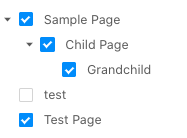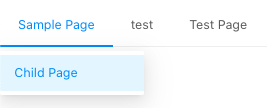Menus
Learn about how to interact with Navigation Menus using WPGraphQL
In WordPress, Navigation Menus consist of 2 types of entities: Menus and MenuItems.
- Menu: is the entity that groups MenuItems together.
- MenuItem: The individual items in a Menu. Each MenuItem can be a custom link, or a reference to a connected object such as a Post, Page, Category, Tag, or other entity. MenuItems can have hierarchical relationships with other MenuItems, meaning MenuItems can be nested with parent/child relationships.
Queries
Below are some examples of querying Menus and Menu Items.
Menu by ID
If you know the ID of a Menu, you can query like so:
GraphiQL Loading...Menu by Name
Often, it can be inconvenient to query Menus by ID. Since Menu names in WordPress are unique the name
can be used as a unique identifier and we can query for Menus by name using the idType argument like so:
Menus
If you are looking for a list of all menus that exist, you can query a list of menus like so:
GraphiQL Loading...Menu Item
If you have the ID of a MenuItem, you can query it directly like so:
GraphiQL Loading...Menu Item by Database ID
If you have the Database ID of a MenuItem, you can query it directly like so:
GraphiQL Loading...Menu Items
Querying a list of Menu Items with no arguments will return Menu Items associated with any Menus.
It's likely more common that you would want to query Menu Items associated with a specific Menu Location, like so:
GraphiQL Loading...Converting a Flat List to Hierarchical List
One thing you may have noticed is that Menu Items will be returned in a flat-list by default, meaning that hierarchical relationships such as parent, children, grand-child Menu Items, will all be returned together in a flat list.
There's a good chance you might need to convert a flat list into a hierarchical list in the consumer application to be used in a component such as a Checkbox Tree or Dropdown Menu, for example.
Given the query above, we might have a payload of data like so:
{
"nodes": [
{
"key": "bmF2X21lbnVfaXRlbTo2Mjk=",
"parentId": null,
"title": "Sample Page",
"url": "http://acf2.local/sample-page/",
},
{
"key": "bmF2X21lbnVfaXRlbTo2MzA=",
"parentId": "bmF2X21lbnVfaXRlbTo2Mjk=",
"title": "Child Page",
"url": "http://acf2.local/sample-page/child-page/",
},
{
"key": "bmF2X21lbnVfaXRlbTo2MzE=",
"parentId": "bmF2X21lbnVfaXRlbTo2MzA=",
"title": "Grandchild",
"url": "http://acf2.local/sample-page/child-page/grandchild/",
},
{
"key": "bmF2X21lbnVfaXRlbTo1NTE=",
"parentId": null,
"title": "test",
"url": "http://acf2.local/test/",
},
{
"key": "bmF2X21lbnVfaXRlbTo1NTI=",
"parentId": null,
"title": "Test Page",
"url": "http://acf2.local/test-page/",
}
],
}Here we can see that there are some nodes with a null parentId value, and some that do have a
parentId value.
A function like the following could be used to convert the flat list to a hierarchical list.
const flatListToHierarchical = (
data = [],
{idKey='key',parentKey='parentId',childrenKey='children'} = {}
) => {
const tree = [];
const childrenOf = {};
data.forEach((item) => {
const newItem = {...item};
const { [idKey]: id, [parentKey]: parentId = 0 } = newItem;
childrenOf[id] = childrenOf[id] || [];
newItem[childrenKey] = childrenOf[id];
parentId
? (
childrenOf[parentId] = childrenOf[parentId] || []
).push(newItem)
: tree.push(newItem);
});
return tree;
};This could be used like so:
$hierarchicalList = flatListToHierarchical( data.nodes );And the data would be transformed to the following:
[
{
"key": "bmF2X21lbnVfaXRlbTo2Mjk=",
"parentId": null,
"title": "Sample Page",
"url": "http://acf2.local/sample-page/",
"__typename": "MenuItem",
"children": [
{
"key": "bmF2X21lbnVfaXRlbTo2MzA=",
"parentId": "bmF2X21lbnVfaXRlbTo2Mjk=",
"title": "Child Page",
"url": "http://acf2.local/sample-page/child-page/",
"__typename": "MenuItem",
"children": [
{
"key": "bmF2X21lbnVfaXRlbTo2MzE=",
"parentId": "bmF2X21lbnVfaXRlbTo2MzA=",
"title": "Grandchild",
"url": "http://acf2.local/sample-page/child-page/grandchild/",
"__typename": "MenuItem",
"children": []
}
]
}
]
},
{
"key": "bmF2X21lbnVfaXRlbTo1NTE=",
"parentId": null,
"title": "test",
"url": "http://acf2.local/test/",
"__typename": "MenuItem",
"children": []
},
{
"key": "bmF2X21lbnVfaXRlbTo1NTI=",
"parentId": null,
"title": "Test Page",
"url": "http://acf2.local/test-page/",
"__typename": "MenuItem",
"children": []
}
]This could then be passed to a component that renders data hierarchically.
For example:
A Checkbox Tree

A Dropdown Menu
